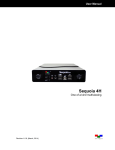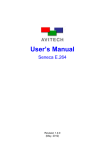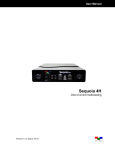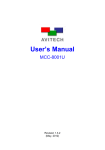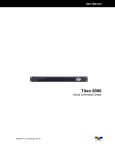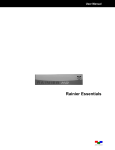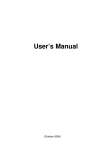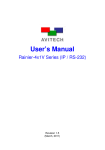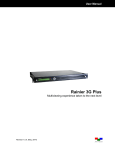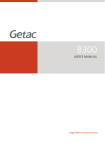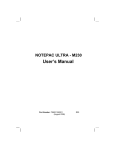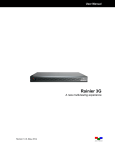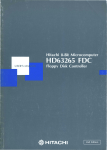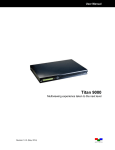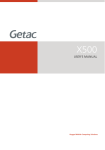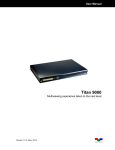Download User`s Manual (EN) - Avitech International Corporation
Transcript
User Manual Sequoia 2H2U One of a kind multiviewing Revision 1.0.3, (May, 2014) User Manual ABOUT THIS MANUAL This manual contains information on how to use the Avitech Sequoia 2H2U mouse keyboard controller. There are 3 chapters in this manual. Getting Started introduces the features and specifications as well as the external components of the Avitech Sequoia 2H2U. System Configuration discusses the process of setting up the Sequoia 2H2U. Basic Operations, introduces the 2 types of operating modes. Using the mouse and keyboard hot-keys to perform basic operations as well as using the touch-screen display with Avitech Sequoia 2H2U. The following conventions are used to distinguish elements of text throughout the manual. provides additional hints or information that require special attention. identifies warnings which must be strictly followed. Any name of a menu, command, icon or button displayed on the screen is shown in a bold typeset. For example: On the Start menu select Settings. To assist us in making improvements to this user manual, we welcome any comments and constructive criticism. Please email us at: [email protected]. WARNING Do not attempt to disassemble the Sequoia 2H2U. Doing so may void the warranty. There are no serviceable parts inside. Please refer all servicing to qualified personnel. TRADEMARKS All brand and product names are trademarks or registered trademarks of their respective companies. COPYRIGHT The information in this manual is subject to change without prior notice. No part of this document may be reproduced or transmitted in any form or by any means, electronic or mechanical for any purpose, without the express written permission of Avitech International Corporation. Avitech International Corporation may have patents, patent applications, trademarks, copyrights or other intellectual property rights covering the subject matter in this document. Except as expressly written by Avitech International Corporation, the furnishing of this document does not provide any license to patents, trademarks, copyrights or other intellectual property of Avitech International Corporation or any of its affiliates. TECHNICAL SUPPORT For any questions regarding the information provided in this guide, call our technical support help line at 425-885-3863, or our toll free help line at 1-877-AVI-TECH, or email us also at [email protected]. ii Contents About This Manual .................................................................................................................... ii Warranty..................................................................................................................................... v Limitation of Liability ................................................................................................................ v Extended Warranty Options..................................................................................................... v Services and Repairs Outside the Warranty Period .............................................................. v Regulatory Information ............................................................................................................ v Federal Communications Commission (FCC) Statement ..................................................... v European Union CE Marking and Compliance Notices ........................................................ v Australia and New Zealand C-Tick Marking and Compliance Notice .................................. v 1. Getting Started ............................................................................................................ 1 1.1 Package Contents .............................................................................................................. 1 1.2 Product Features ............................................................................................................... 3 1.3 Specifications .................................................................................................................... 4 1.4 Connections to the Sequoia 2H2U ................................................................................... 5 2. System Configuration ................................................................................................. 7 2.1 Getting the Sequoia 2H2U Ready ..................................................................................... 7 2.1.1 Basic Setup When Connecting to an Regular or Touch-screen Display......... 7 2.1.2 Basic Setup When Cascading Sequoia Devices .............................................. 10 3. Basic Operations ....................................................................................................... 12 3.1 Host Operation Mode ...................................................................................................... 13 3.1.1 Pop-up Selections ............................................................................................... 13 3.1.2 Functions ............................................................................................................. 13 3.1.3 Hot-keys ............................................................................................................... 14 3.2 Remote Operation Mode ................................................................................................. 15 3.2.1 Hot-keys ............................................................................................................... 15 Appendix A Using the Surfer Feature.......................................................................... 17 A.1 “Surfer” Feature on Uniform Quad Layout That Fills Entire Screen .......................... 17 A.2 “Surfer” Feature on Non-uniform Quad Layout ........................................................... 19 A.3 “Surfer” Feature on Full Screen “Source” Window ..................................................... 19 A.4 “Surfer” Feature on Cascaded System ......................................................................... 20 Appendix B Using the Touch-screen........................................................................... 21 B.1 Lock/Unlock Window Layout .......................................................................................... 21 B.2 Pop-up Selection ............................................................................................................. 22 B.3 Audio Tally ....................................................................................................................... 22 B.4 Move/Resize Window ...................................................................................................... 23 B.5 Exit from Remote Operation Mode to Host Operation Mode ...................................... 23 B.6 Switch Control (Cycle) Between Windows.................................................................... 25 iii Appendix C Using the Touch-to-Mouse Utility (for Windows XP only) ..................... 27 Appendix D Resetting to the Factory-Default State.................................................... 28 iv Warranty Regulatory Information Avitech International Corporation (herein after referred to as “Avitech”) warrants to the original purchaser of the products manufactured in its facility (the “Product”), that these products will be free from defects in material and workmanship for a period of 1 year or 15 months from the date of shipment of the Product to the purchaser. There is a 3 month grace period between shipping and installation. Marking labels located on the exterior of the device indicate the regulations that the model complies with. Please check the marking labels on the device and refer to the corresponding statements in this chapter. Some notices apply to specific models only. Federal Communications Commission (FCC) Statement This equipment has been tested and found to comply with the limits for a Class B digital device, pursuant to Part 15 of the FCC Rules. These limits are designed to provide reasonable protection against harmful interference when the equipment is operated in a commercial environment. This equipment generates, uses, and can radiate radio frequency energy and, if not installed and used in accordance with the instruction manual, may cause harmful interference to radio communications. Operation of this equipment in a residential area is likely to cause harmful interference, in which case the user will be required to correct the interference at his own expense. Properly shielded and grounded cables and connectors must be used in order to meet FCC emission limits. Avitech is not responsible for any radio or television interference caused by using other than recommended cables and connectors or by unauthorized changes or modifications to this equipment. Unauthorized changes or modifications could void the user's authority to operate the equipment. Operation is subject to the following two conditions: (1) this device may not cause harmful interference, and (2) this device must accept any interference received, including interference that may cause undesired operation. If the Product proves to be defective during the 1 year warranty period, the purchaser’s exclusive remedy and Avitech’s sole obligation under this warranty is expressly limited, at Avitech’s sole option, to: (a) repairing the defective Product without charge for parts and labor; or (b) providing a replacement in exchange for the defective Product; or (c) if after a reasonable time is unable to correct the defect or provide a replacement Product in good working order, then the purchaser shall be entitled to recover damages subject to the limitation of liability set forth below. Limitation of Liability Avitech’s liability under this warranty shall not exceed the purchase price paid for the defective product. In no event shall Avitech be liable for any incidental, special, or consequential damages, including without limitation, loss of profits for any breach of this warranty. If Avitech replaces the defective Product with a replacement Product as provided under the terms of this Warranty, in no event will the term of the warranty on the replacement Product exceed the number of months remaining on the warranty covering the defective Product. Equipment manufactured by other suppliers and supplied by Avitech carries the respective manufacturer’s warranty. Avitech assumes no warranty responsibility either expressed or implied for equipment manufactured by others and supplied by Avitech. European Union CE Marking and Compliance Notices Statements of Compliance English This product follows the provisions of the European Directive 1999/5/EC. Dansk (Danish) This Warranty is in lieu of all other warranties expressed or implied, including without limitation, any implied warranty of merchantability or fitness for a particular purpose, all of which are expressly disclaimed. Dette produkt er i overensstemmelse med det europæiske direktiv 1999/5/EC. Nederlands (Dutch) Dit product is in navolging van de bepalingen van Europees Directief 1999/5/EC. This Hardware Warranty shall not apply to any defect, failure, or damage: (a) caused by improper use of the Product or inadequate maintenance and care of the Product; (b) resulting from attempts by other than Avitech representatives to install, repair, or service the Product; (c) caused by installation of the Product in a hostile operating environment or connection of the Product to incompatible equipment; or (d) caused by the modification of the Product or integration with other products when the effect of such modification or integration increases the time or difficulties of servicing the Product. Suomi (Finnish) Tämä tuote noudattaa EU-direktiivin 1999/5/EC määräyksiä. Français (French) Ce produit est conforme aux exigences de la Directive Européenne 1999/5/EC. Deutsch (German) Dieses Produkt entspricht den Bestimmungen der Europäischen Richtlinie 1999/5/EC. Any Product which fails under conditions other than those specifically covered by the Hardware Warranty, will be repaired at the price of parts and labor in effect at the time of repair. Such repairs are warranted for a period of 90 days from date of reshipment to customer. Ελληνικά (Greek) To προϊόν αυτό πληροί τις προβλέψεις της Ευρωπαϊκής Οδηγίας 1999/5/EC. Íslenska (Icelandic) Þessi vara stenst reglugerð Evrópska Efnahags Bandalagsins númer 1999/5/EC. Extended Warranty Options Avitech offers OPTIONAL Extended Warranty plans that provide continuous coverage for the Product after the expiration of the Warranty Period. Contact an Avitech sales representative for details on the options that are available for the Avitech equipment. Italiano (Italian) Questo prodotto è conforme alla Direttiva Europea 1999/5/EC. Norsk (Norwegian) Dette produktet er i henhold til bestemmelsene i det europeiske direktivet 1999/5/EC. Services and Repairs Outside the Warranty Period Avitech makes its best offer to repair a product that is outside the warranty period, provided the product has not reached its end of life (EOL). The minimum charge for such repair excluding shipping and handling is $200 (US dollars). Português (Portuguese) Este produto cumpre com as normas da Diretiva Européia 1999/5/EC. Español (Spanish) Este producto cumple con las normas del Directivo Europeo 1999/5/EC. AVITECH INTERNATIONAL CORPORATION ● 15377 NE 90th Street Redmond, WA 98052 USA ● TOLL FREE 1 877 AVITECH ● PHONE 1 425 885 3863 ● FAX 1 425 885 4726 ● [email protected] ● http://avitechvideo.com Svenska (Swedish) Denna produkt har tillverkats i enlighet med EG-direktiv 1999/5/EC. Australia and New Zealand C-Tick Marking and Compliance Notice Statement of Compliance This product complies with Australia and New Zealand's standards for radio interference. v 1. Getting Started The Avitech Sequoia 2H2U is a highly innovative device. The Sequoia integrates the functions of a KVM (keyboard video mouse) switch and a robust multi-viewer into one enclosure. The Sequoia 2H2U provides a simple solution for any user who works in an environment with multiple computer systems and Pro A/V equipment. With the Sequoia 2H2U seamlessly switch up to 2 computers and 2 video signals; and control up to 2 computers with just one keyboard and mouse. Additionally, its scalability (through cascading) allows the Sequoia to be ideal for both individual users and corporate applications. The Sequoia features a visual user interface (Host operation mode) which allows users to configure the layout through an OSD (on screen display). While in Host operation mode easily convert video images to full screen, adjust windows to any size and move windows to any position. Also, for a hands-on user experience, the Sequoia 2H2U can be used with a touch-screen display. The touch-screen controls are powerful and intuitive; switch sources, resize windows, move windows to any position, and control a remote computer with a tap of your finger. This chapter introduces the features and specifications as well as the external components of Avitech Sequoia 2H2U. 1.1 Package Contents After unpacking the shipping carton, the following standard items can be found: Avitech Sequoia 2H2U Utility Disc (software and user manual) 12 V DC/5A Power Adapter Standard Power Cord (USA customers only) 1 Rubber Foot (4 pcs) D USB-A to USB-B Cable HDMI Cable (optional) D Sequoia 5-in-1 Cable (optional) DVI to HDMI Adapter (optional) D Table 1-1 Package Contents The following items are included if optional rack mount kit is ordered. Front Bracket Power Adapter Tray 2 Multi angle hex driver (2 mm) FH MSH AB 3×6 Screws (12 pieces) Table 1-2 Optional Rack Mount Package Contents 1.2 Product Features The Sequoia 2H2U is HDCP-compliant and capable of HDMI and DVI output (DVI through an adapter). It features automatic detection and selection of optimum display resolution, automatic sensing of input signal, flexible window configuration (any size, any position), Picture-in-Picture (PiP) overlay display, video loss detection, image/gain (can be adjusted manually or automatically), and crop/pan image. The Sequoia can control up to 2 computers and 2 video sources and can automatically detect PS/2 & USB interfaces. It is also hot-pluggable which allows the addition/removal of computers without powering down devices. The Sequoia’s front panel features LED indicators for monitoring the following: Connected Computers (Active or Standby), Operation Mode (Host or Remote) and Power. For audio monitoring the Sequoia 2H2U features two built-in speakers, a 1/8 inch headphone jack and ® an on screen display (OSD) of audio meters. The Sequoia 2H2U accepts embedded/HDMI audio (7.1ch, 5.1ch, 2ch-stereo) and analog audio (stereo). To assist with audio/video re-syncing the Sequoia 2H2U features up to 170ms of audio delay. Fully utilize the flexibility of the Sequoia 2H2U with Avitech’s Phoenix-G software (formerly called Galaxy). With Phoenix-G control software you can easily configure display options, crop/pan images, save up to 23 presets and even program a list of display layouts for the Sequoia to automatically cycle through (“Briefing” feature – refer to Sequoia 2H2U Phoenix-G manual for more details). Moreover, with Avitech’s Hook utility (patent pending), a laptop can be used to control the Sequoia 2H2U via the USB port on the front panel . For larger applications cascade up to 5 Sequoia 2H2U’s and control up to 10 computers and 10 video sources, SDI (3G/HD/SD) CVBS (NTSC/PAL), with just one keyboard and mouse. 1. 2. 3. 4. Non-standard keyboards (e.g., keyboards with a USB hub, keyboards that need driver installation and programmable keyboard, etc.) are not supported. Compatibility between the computer and the Sequoia 4H may depend on the computer’s BIOS Setup. If an incompatibility occurs, you may refer to the computer’s BIOS Setup and make sure USB port and PS/2 port are enabled if these items exist in the computer’s BIOS Setup (typically found in the "Advanced" or "Onboard Device Configuration" menu). Hook utility currently supports the Sequoia solo series (non-cascaded) and the Pacific X-HDU (an HDMI transmitter-Pacific X-HDUT (TX) and an HDMI receiver-Pacific X-HDUR (RX) allows ® transmission of 1080p60 HD over 100 meters based on HDBaseT technology – refer to Pacific X-HDU user manual for more details). Connect a laptop (or desktop) computer to the Sequoia solo series or Pacific X-HDU and simulate keyboard/mouse function for remote control processing (KVM feature). Refer to Avitech Hook utility user manual for more details. 3 1.3 Specifications Input HDMI or DVI (through DVI to HDMI adapter) SDI Automatic sensing HDMI mode: 480i, 480p, 576i, 576p, 720p, 1080i, 1080p DVI-D mode: Up to 1920×1200 Transmission of audio signal is not included when using the DVI to HDMI adapter. Automatic sensing 3G-SDI: 1080p 23.98/24/25/29.97/30/50/59.94/60Hz (up to 100 meters) HD-SDI: 720p, 1080i 50/59.94/60Hz SD-SDI: 480i, 60Hz / 576i, 50Hz NTSC/PAL analog composite signals Output HDMI or DVI (through DVI to HDMI adapter) Automatic sensing or user selectable Up to 1920×1200 (WUXGA) at 50Hz/60Hz or 1600×1200 (UXGA) 75Hz Up to eight channel (7.1) audio configuration Transmission of audio signal is not included when using the DVI to HDMI adapter. Others Peripheral sharing Computer connection Port switching Power Operating System Dimensions/Weight Environment/Safety USB type A port (for USB 2.0 hub) × 2 Up to 2 units (maximum) Method: Keyboard hot-keys (both in Host and Remote operation modes) Mouse OSD (pop-up menu – in Host operation mode) Surfer feature (in Remote operation mode) Power consumption is 25W Power Supply (adapter): Input (AC): 100 to 240V 50Hz/60Hz Output (DC): 12V DC/5A Microsoft Windows 98 Special Edition, 2000 Professional, XP, Vista, Server 2003, Server 2008, Windows 7, Windows 8 Mac (O/S X 10.5 or later version only) Linux OS: Fedora 10, Ubuntu 8.1, Scientific 5.2, RedHat, Mint 6.0, Debian 5.0, PC Linux OS 2009, SUSE 11.1, Mandriva 2009, CentOS 5.2 Note: Windows NT is not supported Dimensions: 261×174×44 mm (10.3×6.9×1.7 inch) Weight: 1.3 kg (2.8 lb) Temperature: Operating: 0 C (32 F) to 40 C (104 F) Storage: –10 C (14 F) to 50 C (122 F) Humidity: 0% to 80% relative, non-condensing Safety: FCC/CE/C-Tick/Class B Table 1-3 Specifications 4 1.4 Connections to the Sequoia 2H2U Figure 1-1 Sequoia 2H2U Components Front Panel Stereo Speaker Set Indicators Embedded speakers for monitoring audio. (Volume can be adjusted and output can be enabled/disabled.) PWR Glows green when the Sequoia 2H2U is turned ON. MODE Glows green when the Sequoia is in Host operation mode. Glows amber when the Sequoia is in Remote operation mode. 1 and 3 Glows green when a particular computer is operating under Remote operation mode (full control through keyboard and mouse). Glows amber when a particular computer is operating under Host operation mode (monitoring only). Blinks amber on a particular re-booting or powered-off computer connected to the Sequoia 2H2U. LED indicators 2 and 4 have been disabled. Audio In/Out Connects to the green connector for headphone function (stereo). Connects to the red connector for microphone function. USB Type A (keyboard/mouse) USB Type B USB Type A (peripheral sharing) Connects to a USB mouse and keyboard. Use these ports for control in Host operation mode. Connects to a remote computer for control through USB mouse and keyboard. These 2 ports can connect to a USB 2.0 hub, USB flash disk, etc. 5 Rear Panel HDMI Output 5-in-1 Input HDMI Input 1/3 BNC Input 2/4 Power (DC 12V) Ethernet (IP) Dip Switches Power Switch HDMI connector for HDMI/DVI output (a DVI to HDMI adapter may be required) Use the Sequoia’s proprietary 5-in-1 cable for connections Inputs 1/3: connect to remote computer’s USB, PS/2 and audio ports Inputs 2/4: connect to an A/V device’s audio connector HDMI connectors for HDMI/DVI inputs (a DVI to HDMI converter may be required) BNC connectors for SDI (3G/HD/SD) CVBS (NTSC/PAL) video inputs. Note: SDI embedded audio is also supported. Connects to the 12V DC/5A power adapter For setup using the Phoenix-G software (Galaxy) and control using ASCII Z commands via a network connection (Protocol: TCP/IP, UDP) Resets the Sequoia to factory-default settings; or updates firmware Turns the Sequoia 2H2U power ON and OFF Table 1-4 Sequoia 2H2U Component Description 6 2. System Configuration This chapter discusses the process of setting up Sequoia 2H2U. 2.1 Getting the Sequoia 2H2U Ready The Sequoia 2H2U can be connected to most monitors and some touch-screen displays. It can also be cascaded with up to five (5) Sequoias for larger applications. To control the Sequoia 2H2U directly, connect a keyboard and mouse to the USB port on its front panel. Alternatively, to control the Sequoia remotely, use a laptop (or desktop) computer and connect to the Sequoia’s USB (type B) port on its front panel, (use a USB A/B cable). Then, run Avitech’s Hook software utility on the controlling computer to simulate mouse and keyboard operation. 1. 2. Hook utility currently supports the Sequoia solo series (non-cascaded) and the Pacific X-HDU (an HDMI transmitter-Pacific X-HDUT (TX) and an HDMI receiver-Pacific X-HDUR (RX) allows ® transmission of 1080p60 HD over 100 meters based on HDBaseT technology – refer to Pacific X-HDU user manual for more details). Connect a laptop (or desktop) computer to the Sequoia solo series or Pacific X-HDU and simulate keyboard/mouse function for remote control processing (KVM feature). Refer to Avitech Hook utility user manual for more details. 2.1.1 Basic Setup When Connecting to an Regular or Touch-screen Display The following figure shows a typical setup with an Avitech Sequoia 2H2U connected to two computers and two A/V devices. DO NOT place any object on the top or side panels of the Sequoia 2H2U. Doing so could affect its internal components and/or its heat dissipation. Figure 2-1 Sequoia 2H2U with Regular Display Setup 7 Figure 2-2 Sequoia 2H2U with Touch-screen Display Setup Step 1. Connect the 5-in-1 cable to the first computer’s USB or PS/2 port and then connect the 5-in-1 cable to its audio ports (mic in, audio out). Connect the other end of the 5-in-1 cable to the Sequoia’s source 1 port (DB15 connector at rear panel). Repeat this process for the second computer and connect to SOURCE 3. 1. 2. We highly recommend using a USB connection instead of a PS/2 connection when available. In case no USB connection is available and a PS/2 connection must be utilized, make sure to first power on the Sequoia 2H2U, then turn on the computer afterwards. (For Windows 2000 users) Upon connecting the Sequoia through USB for the first time to the computer, perform the windows on-screen steps to initialize the USB connection. Step 2. Connect the first A/V device’s audio output to the Sequoia 2H2U’s SOURCE 2 input (DB15 connector on rear panel) via the 5-in-1 cable. Repeat this process for the second A/V device and connect to SOURCE 4. Step 3. Connect a HDMI or DVI (DVI through an adapter) display to the HDMI OUT port on the Sequoia’s rear panel. Step 4. Connect the first computer’s HDMI or DVI (DVI through an adapter) output to the Sequoia 2H2U’s VIDEO IN 1 port (HDMI connection). Repeat this process for the second computer and connect to VIDEO IN 3. Step 5. Connect the first A/V devices BNC output to the Sequoia’s VIDEO IN 2 port with a BNC cable. Repeat this process for second A/V device and connect to VIDEO IN 4. Step 6. Connect the mouse and keyboard to the mouse/keyboard USB ports located on the Sequoia 2H2U’s front panel. When connecting 3 or more devices at the same time such as; a touch-screen, a mouse and a keyboard you can connect a USB hub to increase the number of USB connections. (refer to Figure 2-2) Non-standard keyboards (e.g., keyboards with a USB hub, keyboards that need driver installation and programmable keyboard, etc.) are not supported. Step 7. Connect the provided 12V DC power adapter and then power on the Sequoia. 8 1. For computers using the PS/2 connection instead of a USB connection; re-boot at this time. 2. It is not necessary to re-boot computers connected via USB connection (plug and play feature). Step 8. Move the mouse or press the Pause/Break key to display the Sequoia’s Host cursor (will disappear again after 5 seconds of inactivity). Move the mouse again to display the Host cursor. Step 9. The pop-up menu will appear upon moving the cursor to the window’s top right position. Click the symbol or double-click the left mouse button on the desired window to enter Remote operation mode. Remote operation mode connects you directly to the selected computer. The Sequoia’s (Host) keyboard and mouse will now control the selected computer. Item not applicable for Sequoia 2H2U with touch-screen display setup or PS/2 connection – “Surfer” feature (default setting is “on”) is enabled, moving the mouse to the same border that is shared with another remote computer will cause the Sequoia’s (Host) keyboard and mouse to control another selected computer. Pressing Alt + Ctrl + Shift + F10 will toggle this feature “off” and “on.” When connecting to touch-screen display Press Ctrl + T on the keyboard to perform a screen calibration. This is necessary when connecting to a touch-screen for first time or upon resetting the Sequoia 2H2U. The following symbol will appear in the top left portion of the screen: Use a stylus or a finger to press on the center of the symbol until the next symbol appears (takes approximately five seconds). Perform this step each time the symbol appears (top left, top right, lower left, lower right). Upon completing screen calibration the Sequoia will return to Host operation mode and the four source windows will re-appear on screen. 9 2.1.2 Basic Setup When Cascading Sequoia Devices Cascading is the technique of “daisy-chaining” Sequoia devices (up to 5) through a USB A/B cable. Only the keyboard and mouse are cascaded. Other functions (e.g., audio, video, and USB hub) are not, and depend on the output from each individual computer and the associated Sequoia. (see Figure 2-3) The following figure shows 3 Sequoia 2H2U cascaded together; with each Sequoia 2H2U connected to 2 computers. Cascading is available on the Sequoia 2H2U, 4H and 2x2V. A combination of any of these Sequoia devices can be cascaded to meet custom applications. Figure 2-3 Cascading Three Sequoia 2H2U’s Setup Step 1. Perform steps 1 – 7 for the first Sequoia 2H2U as outlined for Regular Display in the previous section “Basic Setup When Connecting to a Regular or Touch-screen Display.” Step 2. Repeat the above-mentioned steps for the second and third Sequoia 2H2U to be cascaded. Step 3. Connect a mouse and keyboard to the USB ports (first Sequoia only) located on the Sequoia’s front panel. Step 4. Connect first Sequoia’s USB (type-B) port to second Sequoia’s USB (type-A) port using standard USB A/B cable. Repeat this procedure to connect second Sequoia to the third. Step 5. Move the mouse or press Pause/Break key and Host cursor will appear on display (will disappear again after 5 seconds of inactivity). Move the mouse again to display the Host cursor. Step 6. Place the cursor on the display of the master/first Sequoia 2H2U, (the one with the mouse and keyboard connected to it), then perform a system configuration reset by pressing: Ctrl + Shift + Alt + R. The reset takes approximately four seconds for each module. During this process each Sequoia’s Mode – LED turns off, one at a time. Step 7. Move Host cursor across all 3 displays to allow system to complete USB device initialization. If the cursor is unable to move over all three displays, perform steps 5 and 6 again. 10 Step 8. The pop-up menu appears when the Host cursor is moved over the top right portion of a window. Click the symbol or double-click the left mouse button on the desired window to enter Remote operation mode. Remote operation mode connects you directly to the selected computer. The Sequoia’s (Host) keyboard & mouse will now control the selected computer. This item is not applicable for Sequoia 2H2U with touch-screen display cascaded setup or with PS/2 connection – “Surfer” feature (default setting is “on”) is enabled, moving the mouse to the same border that is shared with another remote computer will cause the Sequoia’s (Host) keyboard and mouse to control another selected computer. Pressing Alt + Ctrl + Shift + F10 will toggle this feature “off” and “on.” 11 3. Basic Operations There are 2 types of operating modes while using the Sequoia 2H2U; Host operation mode and Remote operation mode. This chapter discusses both operational modes. Host Operation Mode When the Sequoia 2H2U is in Host operation mode, the Host cursor is controlled by the locally connected mouse device. Or in the case of a cascaded setup the cursor is controlled by the mouse device that is connected to the Master Sequoia. The Host cursor controls the positions and sizes of the windows for up to two remote computers and 2 A/V sources (up to 10 of each when cascaded). Upon re-connecting a keyboard or mouse, the cursor may disappear. Press the Pause/Break key to solve this problem. Remote Operation Mode When the Sequoia 2H2U is in Remote operation mode, the mouse cursor and keyboard are used to control a specific computer connected to the Sequoia 2H2U. Understanding the Terminology: USB host – refers to mouse/keyboard USB ports located on the Sequoia 2H2U front panel. USB device – refers to the DB15 connector (source 1 and 3 ports) located on the Sequoia 2H2U rear panel that connects to the computer’s USB port through the 5-in-1 cable. Tips on Navigating the Sequoia 2H2U: Up to 2 computers and two A/V sources can connect to a single Sequoia 2H2U. Sequoia puts each input source in a window and can display all 4 windows on one output display. Thus, 2 computers and 2 video signals can be displayed and controlled from a single monitor. When Host operation mode is active, use the mouse connected to the Sequoia to re-size and re-position any window on the output display. To switch operation to a remote computer; move the Host cursor into a specific window on the screen and then click the “enter icon” or double-click the left mouse button. Remote operation mode works with computers only, Remote operation mode cannot be entered on video sources (e.g., Blu-Ray player). When Remote operation mode is active, use mouse and keyboard to operate a single computer. Note: The computer is displayed within a window on the monitor. When in Remote operation mode, the master Sequoia 2H2U automatically transfers the mouse and keyboard control to the selected computer. To switch back to Host operation mode, use “Pause/Break” hot-key. Host cursor will reappear. 12 3.1 Host Operation Mode In this mode, monitor a quad screen or double-click the window of the particular computer to be controlled. Following are the basic operations that can be performed in Host operation mode. 3.1.1 Pop-up Selections Upon moving the Host cursor to the top right corner of a window, the following pop-up icons appear. : swap window : enter a computer window : full screen : return from full screen When the Sequoia has detected that a particular computer’s USB (or PS/2) port is not connected, then the enter pop-up icon is not shown on that window (only USB connections are hot-pluggable). 3.1.2 Functions The Sequoia 2H2U allows the swapping of window position, window size adjustment, and audio output selection. Following are the summarized Host operation mode functions. Function Window resizing Window repositioning Window position swapping Full screen window Access a remote computer Lock/unlock window layout Enable/disable audio output Drag the border of a window to a desired size Drag a window to a new position Move the Host cursor to the top right corner of a window, click the S icon and then move the cursor (now a capital letter S) to the destination window and click the left mouse button. Move the Host cursor to the top right corner of a window, click the icon then the window will maximize to full screen. Select to return back from full screen. Method 1: Move the Host cursor to the top right corner of a remote computer window, click to access the Remote operation mode. Method 2: Move the Host cursor so it is on the desired remote computers’ window and double-click. Move the Host cursor to the top left corner of the display until the cursor becomes a capital letter L, then click to lock the window layout. Repeat these steps to unlock the layout. Double-click the audio tally (green) and it will turn to (red) to signify that audio output is coming from a window. Note: To enable an audio output from a source that is not the active window, refer to the Phoenix-G (Galaxy) user manual. Table 3-1 Host Operation Mode Functions 13 3.1.3 Hot-keys Hot-keys are available when utilizing the Sequoia 2H2U under the Host operation mode. Following are the summarized Host operation mode hot-keys. Keys Alt + F# (F1 – F12) Alt + F Alt + L Ctrl + Esc Ctrl + F# (F1 – F4) Ctrl + L Ctrl + O Ctrl + P Ctrl + R Ctrl + S Ctrl + X Ctrl + Y Ctrl + Z Ctrl + Shift + Alt + R F# or Shift + F# Home Page Up/Down Shift + I Use Alt + F1 – F12 function keys (up to F23 with special keyboard) to load user-created preset files. Sequoia can store 23 user created presets. Toggle a particular window’s full screen mode on/off. Note: The window selected is where the Host cursor is currently residing. Toggle lock/unlock window layout This allows Ethernet communication so that you can use the Phoenix-G (Galaxy) control software and sending of ASCII Z commands. Loads the particular window to full screen mode, thereby causing other window(s) to fade from view. Where F# is the source window number (e.g., Ctrl + F1 will call up the source 1 window). In a cascaded system: First move the Host cursor to the desired module then select the source. Toggle lock/unlock keyboard and mouse. When locked the keyboard and mouse are inoperable. This is useful for when users are away. Toggle muting the audio output on/off (mute). Toggle a window on and off. Where P is the source/window number (e.g., Ctrl + 1 will turn on/off the source 1 window). Toggles between aspect ratios, for the window that the Host cursor is on. Settings: 4:3, 16:9 and off. Saves the latest preset to the Sequoia so that on the next boot-up the latest preset will be loaded. Note: Also simultaneously saves latest presets for cascaded modules. When a video signal does not fill up the entire frame a black bar fills in the empty space that is left behind. Pressing Ctrl + X crops off the black bars. When applying this function, make sure the image does not have a black or dark grey background to avoid cropping off part of the actual image. Note: Only applicable for HDMI and DVI input signals (SDI not supported) Redo: redo up to ten previously “undone” actions. Undo: undo up to ten previous actions. Reset the cascaded module’s system configuration only. Access a remote computer (F# represents keys F1 or F2). F1 corresponds to the Source 1 window while F2 corresponds to the Source 3 window. Window swapping can be enabled/disabled from the Phoenix-G (Galaxy) control software. When the parameter inside the Phoenix-G (Galaxy) software “Swap with Active Window” is enabled (under the Sequoia Properties menu) then: Upon Pressing F#: The active window and the selected window swap positions. And selected window enters Remote operation mode. Upon Pressing Shift + F#: Selected window enters Remote operation mode (no swapping). When the parameter “Swap with Active Window” is disabled then: Upon Pressing F#: Selected window enters Remote operation mode (no swapping). Upon Pressing Shift + F#: The active window and the selected window swap positions. And selected window enters Remote operation mode. When in full screen mode, toggle between full screen in foreground and full screen in background. Switch between the 3 factory-default presets. Switch audio input source between HDMI IN and source ports. Audio tally (red) signifies that audio output is coming from a particular window. 14 Keys Shift + L Shift + O Shift + / Shift + Toggle priority of overlaying windows on/off – upon clicking a window will not cause the window to become the topmost window. Switch the audio output between the Sequoia’s internal speakers and the HDMI OUT port. Note: This function is not available when connected to the HDMI OUT port via a DVI-to-HDMI adapter. Due to subtle differences in processing times; the audio and video may need to be re-synced, this is done by adjusting the audio delay. The Sequoia provides up to 170 milliseconds of audio delay adjustment. Use (Shift + ) to decrease delay and (Shift + ) to increase delay. (red LED) Move the Host cursor from one display (monitor) to the other (applicable only during cascading). Decrease/increase the volume level (10 levels including mute). Tab / (green LED) Load the previous user-created preset file. Note: Use the Phoenix-G (Galaxy) control software to create and save your own presets. Load the next user-created preset file. Table 3-2 Hot-keys of Host Operation Mode Pressing Ctrl + Esc hot-keys as well as the “Load Preset” action will clear the undo (Ctrl + Z) and redo (Ctrl + Y) list in memory. 3.2 Remote Operation Mode 3.2.1 Hot-keys The following hot-keys are only available when utilizing Sequoia 2H2U under Remote operation mode. Keys Pause Break Ctrl + Esc Ctrl + Shift + Alt + F10 Exit from the Remote operation mode to the Host operation mode. This command allows Ethernet communication so that you can use the Phoenix-G (Galaxy) control software. Note: 1. Pressing Ctrl + Esc will also open up the Windows start menu. This is okay, simply exit the Windows start menu and proceed. 2. To disable “Surfer” feature (next hot-key description), pressing Ctrl + Esc and then running and quitting Phoenix-G software can accomplish this. “Surfer” feature will automatically be enabled upon entering “Host operation mode” and then entering “Remote operation mode.” Toggles the “Surfer” feature on and off; wherein upon moving mouse to same border that is shared with another remote computer will cause the Sequoia’s (Host) keyboard and mouse to control next selected computer. Note: 1. Not applicable for Sequoia 2H2U with touch-screen display setup or with PS/2 connection. 2. Not applicable after pressing the above-mentioned Ctrl + Esc hot-key and then running and quitting Phoenix-G software. “Surfer” feature will automatically be enabled upon entering “Host Operation Mode” and then entering “Remote operation mode.” 3. Refer to Appendix A for more details. 15 Keys Ctrl + Shift + Alt + V Ctrl + Pause Break or Shift + Pause Break This command is used to read the Sequoia’s USB device firmware version (DB15 connector (source 1 and 3 ports) located on the Sequoia 2H2U rear panel that connects to the computer’s USB port through the ® 5-in-1 cable). Open Microsoft Notepad and then press Ctrl + Shift + Alt + V to paste the firmware text to Notepad. Note: This function is only available when the computer and Sequoia are connected via the 5-in-1 cable’s USB port. Switch control (cycle) from window 1window 3window 1, and so forth. The controlling function is available only if the computer and Sequoia 2H2U are connected via the 5-in-1 cable. Note: 1. If only one computer is connected, then no switching would occur. 2. Not applicable after pressing the above-mentioned Ctrl + Esc hot-key. Hot-key function will automatically be enabled upon entering “Host Operation Mode” and then entering “Remote operation mode.” Table 3-3 Hot-keys of Remote Operation Mode When using Apple’s MacBook computer, use “control + option (Alt) + shift + k” to perform Host/Remote operation mode switch because there is no “Pause/Break” key. 16 Appendix A Using the Surfer Feature “Surfer” feature is not available for Sequoia 2H2U with touch-screen display setup or with PS/2 connection. The “Surfer” feature is designed for ease of transferring control from one remote computer window to another. Just moving the mouse to the nearest side border of another remote computer will cause the Sequoia’s (Host) keyboard and mouse to transfer control to next selected computer. By default, the “Surfer” feature is enabled upon starting up the Sequoia 2H2U. The Ctrl + Shift + Alt + F10 hot-keys allow you to toggle “Surfer” feature on and off. “Surfer” feature will be disabled after pressing Ctrl + Esc hot-key and then running and quitting Phoenix-G software. “Surfer” feature will automatically be enabled upon entering “Host Operation Mode” and then entering “Remote operation mode.” A.1 “Surfer” Feature on Uniform Quad Layout That Fills Entire Screen Below figure shows the allowed “Source” window control switching action upon moving the mouse to the window sides “with arrow” and “shaded line” indicators. Moving the mouse from one “Source” window to the other transfers control from the former window to the target window. No “Source” window control switching action will occur upon moving the mouse to the window sides “without arrow” and “shaded line” indicators. Figure A-1 “Surfer” Feature on Default Preset 1 Default setting of item Swap with active window (Phoenix-GSettingsSystem ParameterSequoia Properties U.I.) is enabled (with checkmark), so swapping of active window position will also take place. 17 Figure A-2 “Surfer” Feature on Default Preset 2 Figure A-3 “Surfer” Feature on Default Preset 3 18 A.2 “Surfer” Feature on Non-uniform Quad Layout Below figure shows possible “Source” window control switching action upon moving the mouse to the window sides “with arrow” and “line” indicators. Moving the mouse from one “Source” window to the other transfers control from the former window to the target window. No “Source” window control switching action will occur upon moving the mouse to the window sides “without arrow” and “line” indicators. Figure A-4 “Surfer” Feature on Non-uniform Quad Layout 1. In case of overlay “Source” windows, switching of control will occur when mouse cursor has left the area where the 2 “Source” windows overlay into the target window. 2. Default setting of item Swap with active window (Phoenix-GSettingsSystem Parameter Sequoia Properties U.I.) is enabled (with checkmark), so swapping of active window position will also take place. A.3 “Surfer” Feature on Full Screen “Source” Window Below figure shows possible “Source” window control switching action upon moving the mouse to the window sides “with arrow” and “line” indicators. Moving the mouse from one “Source” window to the other transfers control from the former window to the latter one. No “Source” window control switching action will occur upon moving the mouse to the window sides “without arrow” and “line” indicators. Figure A-5 “Surfer” Feature on Full Screen “Source” Window 19 A.4 “Surfer” Feature on Cascaded System Below figure shows a sample 3 Sequoia 2H2U cascaded system. The “Surfer” feature is confined within each Sequoia only. (refer to the abovementioned illustrations on using the “Surfer” feature within each Sequoia) For example: if user is currently in control of “Source 1” computer window of Sequoia 2 (Remote operation mode); and wishes to switch control to “Source 3” computer window of Sequoia 3 (Remote operation mode), perform the following: Step 1: Press Pause/Break key (or double-click the middle wheel mouse button) to exit (Remote operation mode) and enter (Host operation mode). Control of “Source 1” computer window of Sequoia 2 has now been disengaged. Step 2: Move the Host cursor to the right edge of the display of Sequoia 2 to allow it to jump to left edge of the display of Sequoia 3 (still in Host operation mode but this time location of Host cursor is now in Sequoia 3). Pressing Tab key can also move Host cursor from Sequoia 2 display to Sequoia 3 display (Tab key only moves in a clockwise cascaded direction – to move in a counterclockwise cascaded direction, the mouse cursor can be moved to the left edge of the display to effect this action). Step 3: Move the Host cursor over the top right portion of “Source 3” computer window of Sequoia 3 to click the symbol of the pop-up menu Or, double-click the left mouse button on the desired window to switch control to it (enter Remote operation mode). The “Surfer” feature can now be used within Sequoia 3. Legend: Host operation mode action (moving between Sequoia 2H2U) = dotted line and arrow (no fill) Remote operation mode action (within a particular Sequoia 2H2U) = shaded line and arrow (with fill) Figure A-6 “Surfer” Feature on Cascaded System Up to 5 Sequoia 2H2U can be cascaded. 20 Appendix B Using the Touch-screen When using a touch-screen monitor with the Sequoia 2H2U for the first time or after a factory reset make sure to perform a screen calibration. (For details refer to Chapter 2.1.1, “Basic Setup When Connecting to a Touch-screen Display.”) B.1 Lock/Unlock Window Layout Use the finger (or stylus) to tap the top left corner of the monitor until a capital letter “ L” is displayed then tap the “L” symbol twice and the current layout will be locked. Repeat these steps to unlock the layout. Figure B-1 Touch-screen: Lock/Unlock Window Layout 21 B.2 Pop-up Selection Use a stylus (or finger) to tap the top right corner of a window and the following icons will appear: ( / / ). To execute an icons’ function press on it for approximately 1 second. To perform the “swap window function,” press on the destination window. icon for 1 second, and then tap twice on the Figure B-2 Touch-screen: Pop-up Selection B.3 Audio Tally To enable audio output on any window, tap twice on the audio tally to signify that audio output is coming from the window. (green) and it will turn to (red) By default, audio output corresponds to the active window. To enable audio output from a source other than the active window, use the Phoenix-G (Galaxy) control software and disable the item Audio Output from Active Window (remove checkmark) under SettingsSystem ParameterSequoia Properties. 22 B.4 Move/Resize Window To move a window, tap anywhere near the center of the window and when the drag the window to a new position. symbol appears, To resize a window, tap anywhere near the edge of the window and when the directional arrows appear, drag the windows’ border to the desired size. Figure B-3 Touch-screen: Move/Resize Window B.5 Exit from Remote Operation Mode to Host Operation Mode To exit from Remote operation mode to Host operation mode tap twice anywhere outside the “active” Remote window. This includes tapping twice on any of the other windows. Figure B-4 Touch-screen: Exit Remote Operation Mode 23 To exit from (Full Screen) Remote operation mode; press the upper or lower inch of the touch-screen for approximately 1.5 seconds. Note: Figure B-5 indicates these areas with the black rectangles. Figure B-5 Touch-screen: Exit Remote Operation Mode (When in Full Screen) 24 B.6 Switch Control (Cycle) Between Windows To switch control from window 1window 2; press anywhere on window 2 for approximately 0.5 second. When the “Swap with Active Window” parameter is set to (ON) then switching control from window 1window 2 will also swap the locations of the windows. The “Swap with Active Window” parameter can only be adjusted using the Phoenix-G (Galaxy) control software. Figure B-6 Phoenix-G Utility: Swap with Active Window 25 To switch Sources (cycle) while in Full Screen Remote operation mode; press within an inch of the left or right edges of the touch-screen and hold for approximately 1.5 seconds. (Refer to Figure B-7.) Cycle forward: press right side of screen: window 1window 2window 3window 4 window 1 Cycle Backward: press left side of screen: window 1window 4window 3window 2window 1 Figure B-7 Touch-screen: Switch Sources while in Full Screen Mode 26 Appendix C Using the Touch-to-Mouse Utility (for Windows XP only) The Touch-to-Mouse utility is designed for use with a touch-screen monitor and a remote computer running Windows XP. To start the Touch-to-Mouse utility, perform the following steps: Step 1. Copy the file “Sequoia USB Touch Tool.exe” to the designated computer. Step 2. Double-click the file: “Sequoia USB Touch Tool.exe”. Step 3. Right-click the Touch-to-Mouse icon ( ) appearing on Windows taskbar, select Settings. Step 4. Set the Double-click Speed with the slider or enter the time in (ms). Note: two successive taps on the touch-screen mimics double-clicking the left-mouse button. Figure C-1 Touch-to-Mouse Utility Setup Step 5. Set the Right Key Trigger with the slider or enter the time in (ms). To mimic the action of the right-mouse button hold your finger on the touch-screen until the specified time has elapsed. Step 6. Then click Hide when finished. To automatically start Touch-to-Mouse upon the next Windows XP boot-up, right-click the Touch-to-Mouse icon and select “Auto-start when Windows starts-up.” (A checkmark will appear signifying it is enabled.) 27 Appendix D Resetting to the Factory-Default State To reset your Sequoia to its factory-default state, perform the following steps: Step 1. Power-off the Sequoia by pressing the power switch. Step 2. Push number 2 (middle) dip switch located on Sequoia’s rear panel downward to ON position. Figure D-1 Push the Number 2 (Middle) Dip Switch Step 3. Power-on the Sequoia by pressing the power switch. Step 4. Push back the number 2 (middle) dip switch upward to the default position. Upon resetting your device to factory-default state, your previously saved preset files will be automatically removed. You need to use the Phoenix-G software to set output resolution and create preset file(s) again. 28


































